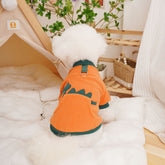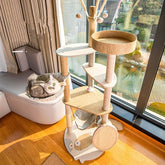Understanding Feline Nail Care: A Comprehensive Guide to Cat Claw Maintenance
Table of Contents
- Key Highlights:
- Introduction
- The Natural Shedding Process: Declawing Without the Drama
- Recognizing Healthy Claw Care
- Frequently Asked Questions (FAQs) About Cat Claw Care
Key Highlights:
- Cats naturally maintain their claws through a biological process called onychoptosis, which involves shedding the outer sheath of the claws.
- Scratching serves multiple purposes for cats, including sharpening claws, marking territory, and providing emotional release.
- Recognizing signs of healthy claws and knowing when to intervene are essential for responsible cat ownership.
Introduction
Cats are known for their meticulous grooming habits, which play a critical role not only in their appearance but also in their overall well-being. Among the various aspects of feline grooming, claw maintenance often raises questions among pet owners. How do cats manage to keep their claws sharp and healthy without human intervention? Understanding this natural process is essential for providing optimal care for your feline companion. This article delves into the intricacies of how cats maintain their claws, the significance of scratching, and the best practices for ensuring your cat's claws remain healthy and well-managed.
The Natural Shedding Process: Declawing Without the Drama
Contrary to some misconceptions, cats do not rely on the equivalent of human nail clippers to manage their claws. Instead, they possess a unique biological mechanism known as onychoptosis. This natural shedding process allows them to dispose of the outer layer of their claws, maintaining sharpness and functionality akin to how snakes shed their skin.
How it Works
The structure of a cat's claw consists of multiple layers of keratin, the same protein that forms human nails and hair. As a cat's claw grows, new keratin layers form at the base, causing the older layers to become damaged or dull over time. To facilitate the shedding of this outer layer, cats engage in scratching behavior. Scratching serves to loosen the sheath, allowing it to naturally peel away, revealing a sharper claw underneath.
Why Scratching is Essential
The act of scratching is indispensable for cats, fulfilling several essential functions beyond mere nail maintenance:
- Sharpening Claws: Scratching efficiently removes the outer sheath, revealing the sharper claw beneath.
- Marking Territory: With scent glands located in their paws, cats use scratching as a means to mark their territory visually and olfactorily, sending signals to other cats.
- Stretching and Exercising: Scratching allows for muscle stretching and exercise, particularly beneficial for their back and shoulder muscles.
- Emotional Release: The act of scratching can provide an outlet for cats to relieve stress and frustration.
The Scratching Post: A Cat’s Best Friend
To support their natural scratching instincts, providing appropriate scratching surfaces is crucial. A well-designed scratching post should meet the following criteria:
- Height: A scratching post should be tall enough for the cat to fully extend its body while using it.
- Sturdiness: Stability is vital; the post should not wobble or tip over during use.
- Material: Popular materials include sisal rope, carpet, and cardboard. It's beneficial to experiment to discover your cat's preferences.
- Strategic Placement: The scratching post should be situated in a prominent location, ideally near a favorite resting area or high-traffic space.
Recognizing Healthy Claw Care
It's essential for cat owners to understand what constitutes healthy claw maintenance. Below are indicators of optimal claw health:
Signs of Healthy Claws
- Claws should be sharp and well-defined.
- The outer sheath should be shed regularly.
- The cat should exhibit consistent scratching behavior on designated surfaces.
- There should be no indications of injury, infection, or discomfort.
When to Intervene: Recognizing Potential Problems
While cats are adept at self-maintenance, there are instances requiring human intervention. Key warning signs include:
- Overgrown Claws: If a claw grows excessively long, it may begin to curl, causing pain or injury.
- Ingrown Claws: Similar to overgrown claws, if they penetrate the paw pads, it can lead to significant discomfort.
- Broken or Damaged Claws: Injuries to claws can induce pain and raise the risk of infection.
- Claw Infections: Symptoms include redness, swelling, discharge, and noticeable lameness.
Safe Nail Trimming Techniques (When Necessary)
For instances when a cat's claws require trimming, it's paramount to approach the task with care. Owners should always use cat-specific nail clippers, whether scissor-style or guillotine-style. When trimming, identifying the quick—the pink area imbued with blood vessels and nerves—is crucial to avoid pain and bleeding. If uncertain, it is advisable to seek assistance from a veterinarian or professional groomer.
Frequently Asked Questions (FAQs) About Cat Claw Care
1. My cat doesn’t scratch on the scratching post. What can I do?
Cats can be particular about their scratching preferences. Try offering various types of scratching surfaces—vertical, horizontal or made from different materials. Introducing catnip can encourage use, while placing treats or praise when your cat interacts with the post can reinforce the behavior. Ensure easy access to the scratching post by placing it in frequented areas.
2. How often should I trim my cat’s nails if they don’t seem to shed them properly?
Regular nail inspections are essential. If your cat's nails are not shedding as they should, trimming every 2-3 weeks is generally recommended. However, the frequency may vary based on individual circumstances and environment.
3. What if I accidentally cut the quick?
In the unfortunate event of cutting the quick, use styptic powder to halt the bleeding. If unavailable, cornstarch can be used as a substitute. Apply pressure to the area for several minutes. Should bleeding persist, seek veterinary consultation promptly.
4. Is declawing a humane option for preventing scratching?
Declawing is widely recognized as an inhumane practice. The procedure involves surgically removing the last bone of each toe, which can lead to chronic pain and behavioral issues. Many countries have banned declawing altogether, prompting owners to consider alternatives such as scratching posts, trimming, or nail caps.
5. What are nail caps and how do they work?
Nail caps are small plastic coverings that are glued onto a cat's claws. They prevent damage from scratching while allowing the cat to extend and retract their claws naturally. Typically, nail caps need to be re-applied every few weeks.
6. Can I use human nail clippers on my cat?
No, human nail clippers are not suitable for cat claws and can lead to injury. Always utilize clippers specifically designed for feline nail care.
7. My cat is very resistant to nail trimming. What can I do to make it easier?
To facilitate a smoother nail-trimming experience, introduce the process gradually and associate it with positive interactions. Use treats or praise to create a positive atmosphere. If resistance continues, consider consultation with a professional groomer or veterinarian.
8. How do I choose the right scratching post for my cat?
Observe your cat’s scratching habits—do they prefer vertical or horizontal surfaces? Consider testing different materials, ensuring stability and height for optimal stretching.
9. Why is my cat scratching furniture even though they have a scratching post?
If a cat is still scratching furniture, the scratching post may not be enticing or might be positioned inappropriately. It can be helpful to relocate the post near the furniture and analyze whether the materials are appealing to your cat.
10. What should I do if I suspect my cat has a claw infection?
Immediate veterinary consultation is vital if you suspect an infection. Symptoms can include redness, swelling, discharge, and excessive licking. Timely intervention helps avert serious complications.
By understanding the natural process of feline claw care and providing adequate enrichment, you can help your cat maintain healthy claws and a happy lifestyle. While cats generally manage their claw maintenance expertly, pet owners should recognize when intervention is necessary to ensure their feline friend’s well-being. The bond between cat and owner can be strengthened through proper care, empathy, and attention to detail in all aspects of your cat's life.





